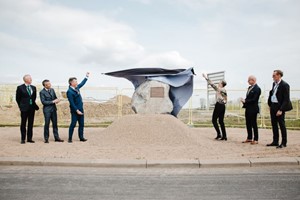News
Topsoe celebrates milestone in construction of industrial-scale SOEC electrolyzer facility
Topsoe, a global leader in carbon emission reduction technologies, is dedicated to delivering the solutions needed to decarbonize hard-to-abate sectors such as aviation, shipping, long-haul transportation as well as heavy industry, responsible for around 30% of global emissions.
To meet climate goals, Topsoe is constructing the first industrial-scale solid oxide electrolysis cell (SOEC) facility to manufacture electrolyzers to produce green H2. Green H2 is the important building block to get clean fuels and chemicals to fuel a sustainable future. With the new factory, Topsoe is making the case for SOEC technology on an industrial scale. The factory will have an initial 500-MW manufacturing capacity.
Topsoe’s SOEC technology is up to 35% more efficient than conventional technologies, enabling a more efficient green H2 production to help meet global decarbonization targets. The construction of the manufacturing factory is well underway with the main building already in place.
To reach net zero on a global scale in 2050 an estimated 3670-gigawatts of installed electrolysis capacity is required by 2050. A prerequisite for having enough installed electrolyzer capacity, that enables industry producing green H2, is to build up manufacturing capacity at speed. And that is exactly what Topsoe is doing.
Roeland Baan, CEO at Topsoe, said, “The case for using electrolysis technology to produce green fuels is well established, but actual manufacturing capacity is needed at speed. We are facing this challenge head on. Our climate is in crisis and in need of resolute and massive solutions to cut emissions and turn the tables on climate change, ensuring a better world for generations to come. In combination with foresightful partners and customers and strong public-private sector collaboration, we’ll be able to make a substantial contribution to the energy transition, help secure energy independence, and fuel the green economy in Europe and globally.”
Kim Hedegaard, CEO Power-to-X at Topsoe, said, “Our factory will take high-temperature electrolysis from the laboratory environment to industrial scale and provide the first industrial use case. Our SOEC technology helps to answer the question of how to turn on the power when the winds aren’t blowing, and the sun isn’t shining, as green H2 and its derivatives can be stored and ready to use when we have a deficit in renewables. It also bridges the gap between renewable energy and the hard-to-abate sectors, that we in Topsoe are determined to decarbonize.”


